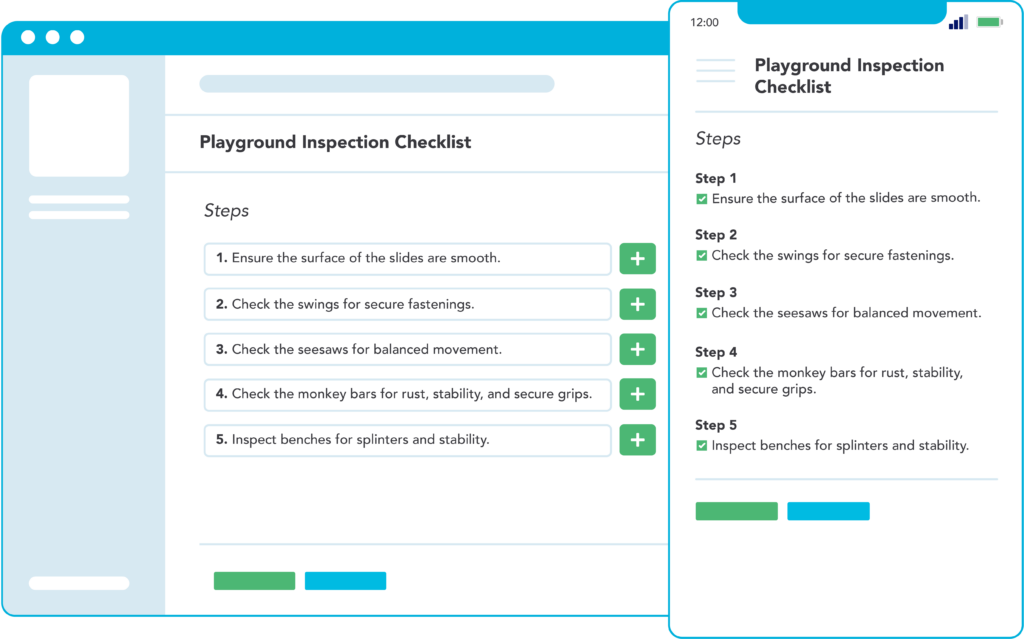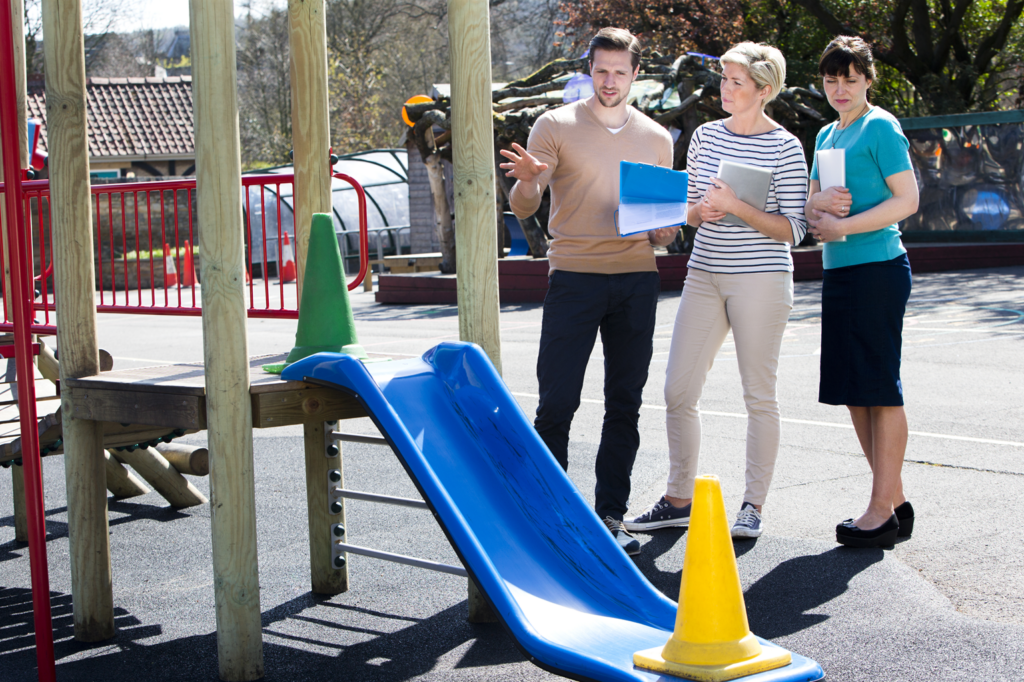Key takeaways you will find in this article
- •Playground inspection checklists are essential tools that help maintain safety standards and prevent accidents
- •Effective playground checklists can help prevent injuries, increase community satisfaction, and decrease costs
- •Facilities maintenance software creates playground inspection checklists for schools and municipalities alike
Table of contents
- Why are playground inspections important?
- Types of equipment needing inspection in your playground safety checklist
- Benefits of regular playground inspections
- How to set up a playground inspection program
- Playground safety checklist template
- How facilities management software can help with playground inspection checklists
Playgrounds are essential spaces for the schools and families they serve. They offer opportunities for physical activity and social interaction.
To ensure these environments remain safe and enjoyable, regular inspections are crucial.
Playground inspection checklists are essential for performing routine maintenance of these assets. They are critical tools that help maintain safety standards and prevent accidents.
If your organization has a a playground, performing regular inspections and maintenance is part of a comprehensive facility inspection program.
This blog post highlights the importance of using these checklists and guides you on how to utilize them effectively.
Why are playground inspections important?
Playground inspections are not just about maintaining aesthetics. They are critical for ensuring the safety and well-being of children. Regular inspections can prevent accidents by identifying and addressing potential hazards before they cause harm. Here are some key reasons why playground inspections are important:
Prevent injuries: Identifying and fixing hazards reduces the risk of injuries from faulty equipment or unsafe conditions.
Compliance with regulations: Adhering to playground safety standards helps avoid legal issues and ensures the playground meets all regulatory requirements.
Prolong equipment lifespan: Regular maintenance can extend the life of playground equipment, saving money in the long run.
Create more enjoyment: Well-maintained playgrounds provide a better experience, encouraging more frequent use and enjoyment.
Subscribe to expert insights for operations leaders
Be the first to know about new tips, best practices, procedures, templates, and digital tools from our industry experts.
"*" indicates required fields
Types of equipment needing inspection in your playground safety checklist
Different types of playground equipment require regular inspections to ensure safety and functionality. Here’s an overview of common playground equipment and the specific maintenance checks needed:
Slides
- Ensure the surface is smooth and free of cracks or sharp edges
- Regularly clean and inspect for wear and tear
Swings
- Check for secure fastenings and wear on the seats and chains
- Lubricate moving parts and replace worn-out components
Climbing frames
- Inspect for stability, rust, and wear on connecting parts
- Tighten bolts and screws, and treat rust spots promptly
Seesaws
- Ensure balanced movement and check for secure handles and seats
- Lubricate pivot points and replace damaged parts
Monkey bars
- Check for rust, stability, and secure grips
- Regularly inspect and treat rust, tighten loose grips
Spring riders
- Ensure springs are intact and securely attached to the ground
- Check for wear on the springs and mounting points
Benches and picnic tables
- Inspect for splinters, stability, and secure fastenings
- Sand down rough edges and tighten loose fastenings
Benefits of regular playground inspections
Regular playground inspections offer numerous benefits, ensuring the safety and satisfaction of users while extending the lifespan of the equipment. Here are the primary benefits:
Improve safety
Regular inspections help identify potential hazards, reducing the risk of injuries. Safe playgrounds mean fewer accidents and a safer environment for children to play.
Extend equipment lifespan
Routine maintenance and inspections can prevent small issues from becoming major problems, thereby extending the life of playground equipment and saving costs on replacements.
Compliance with regulations
Adhering to safety standards and regulations helps avoid legal complications and ensures that the playground meets all required safety criteria.
Enhanced user satisfaction
Well-maintained playgrounds provide a better experience for users, encouraging more frequent visits and positive feedback from the community.
How to set up a playground inspection program
Setting up an effective playground inspection program involves several steps to ensure comprehensive coverage and consistent monitoring. Here’s how to set up your program:
Select equipment to inspect
Identify all playground equipment and facilities that need regular inspections. This includes not only play structures but also seating areas, pathways, and the playground surface.
Analyze equipment condition
Assess the current state of each piece of equipment. Look for signs of wear and tear, potential hazards, and areas needing immediate attention.
Collect data
Gather information on equipment usage, wear patterns, and past maintenance activities. This data will help in planning and prioritizing inspections.
Develop playground inspection checklists schedules
Create a timeline for regular inspections, including daily, weekly, monthly, and yearly checks. Each schedule should be tailored to the specific needs and usage patterns of the equipment.
Monitor the proper maintenance plan and adjust as necessary
Regularly review inspection outcomes and update the plan based on findings. This ensures that the inspection program remains effective and responsive to changing conditions.
Playground safety checklist template
Utilizing a comprehensive playground inspection checklist is essential for effective preventive maintenance. These checklists can be tailored for different inspection frequencies—daily, weekly, monthly, quarterly, and yearly. Each checklist should cover all critical aspects of the equipment and surroundings to ensure nothing is overlooked. Whether a school or park, these checklists are essential parts of an operation.
How facilities management software can help with playground inspection checklists
Facilities management software can streamline the process of creating, monitoring, and assessing playground inspection checklists.

Create and monitor checklists to avoid a safety hazard
Preventive maintenance capabilities of facilities management software allows you to create customized inspection checklists and schedules. You can also track inspection completion and monitor maintenance teams’ performance.
Benefits of using FMX for safety inspections
FMX helps prioritize work orders based on the severity and urgency of issues identified during inspections. This ensures that critical maintenance tasks are addressed promptly and your organization follows preventive maintenance best practices.
By utilizing a robust inspection program and leveraging facilities management software like FMX, you can ensure that your playgrounds remain safe, compliant, and enjoyable for all users. Regular inspections not only prevent accidents but also enhance the longevity and overall user experience of playground equipment.
Interested in learning more? Reach out today to schedule a demo with our team.
Written by
Zach Jones
Content Manager at FMX
